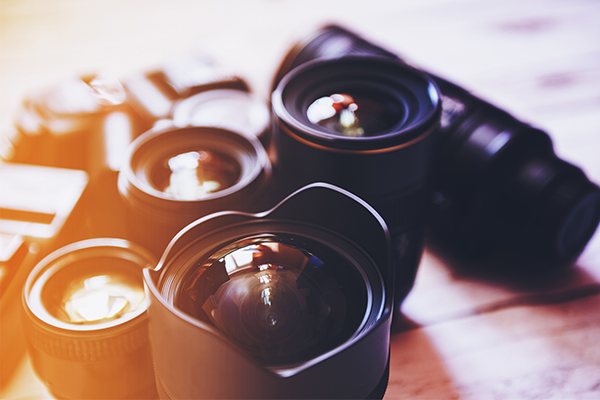Choosing the Right Lens
For those of you who are just starting out in the video world, or maybe even thinking about buying something for your small business needs, there are a few things to consider beyond what type of camera to get. Mainly, what type of glass you should buy with the camera – especially if it’s a DSLR. Of course, by “glass” I mean lenses.
There are zoom lenses, prime lenses, photo-specific lenses, cinema-style lenses, and they all have different price brackets and brands. Lenses are often overlooked and the last thing some people want to invest in, but they’re just as important as the camera you choose. Let’s explore cine-style lenses vs. standard (photo) lenses.
Photo Lenses:
These lenses most commonly come in two flavors: primes (lenses that have no zoom function) and zoom lenses. Zooms allow you to smoothly change the focal length (ie: 35mm) without having to move the camera around. So, when you see, for instance, “24 – 70” on a lens, you know that it runs the spectrum from 24mm to a focal length of 70mm. For videographers in “run-and-gun” situations, like when you’re out filming live events or b-roll, these are the best option. They give you the most flexibility for shooting in fast-moving environments.
The biggest advantage of a zoom lens is the ability to control the aperture directly from the camera. The aperture is the opening that controls the amount of light that hits the camera’s sensor – which you probably know as F-stop or iris control.
They also allow you to auto-focus directly from the camera, as opposed to the lens itself. Though it should be noted that not all auto-focus systems are created equal (the Canon C-series has one of the best auto-focus systems) and even the best should be used sparingly! In most professional environments, if you only rely on auto-focus, you risk critical shots being completely unusable.
If you’re looking to purchase (or try out) a zoom lens, look for those (especially for video) that offer a constant aperture. This means that the image won’t get “darker” as you zoom in. Since standard photography lenses are designed around the F-Stop, the ratio between the focal length and the diameter of the iris within the lens, you want the F-stop setting (ie: f2.8) to remain at the same setting throughout the zoom range. The less expensive zoom lenses will automatically adjust the F-stop, or aperture, as you zoom, limiting smooth zooms and constant settings.
Cinema Lenses:
Just like with their cheaper, photography-centric counterparts, these also come in zoom and prime, but they work (and look) very different. These lenses are mostly all manual. Though in some circumstances, cine lenses do have a zoom rocker switch on the side of the lens. These lenses are very popular on ENG-style cameras.
But what makes these lenses so different from standard lenses?
I’m glad you asked! Cine lenses are designed around the Transmission Stop, or “T-Stop”, these are very different from an “F-stop”, which we’re all familiar with. A T-Stop, is an exact measurement of light that enters through the iris and lands on the camera’s sensor.
Why is this important?
Well if you have a full set of cinema lenses, let’s say from SLR Magic with a T-Stop value of T2.1, because they were all made as part of a set, the amount of light will be the same across the board at T2.1.
Most cine zoom lenses are parfocal. This means that as you zoom in and out, the focus will not change. Where in Photo lenses, you might have to make slight adjustments when zooming (the back-focus can have issues or adjustments).
The other big benefit of cinema lenses is how smooth the gears are. Because cinema lenses offer industry-standard gearing, the first assistant camera person can easily change our focus point within the scene. The same goes for the iris. If you have a shot that moves from outside to indoors, you can do this very smoothly on a professional lens.
Finally, most cine lenses are designed to be the same size and weight, especially if they are part of a kit. This makes it easier to change out a lens when using a matte box or not having to rebalance a gimbal.
Yeah, it’s a lot to take in, and this is really just a high-level overview of some of the differences between photography lenses and professional cinema lenses. There are many, many brands out there and at different price points. If you’re serious about creating professional narrative projects and have the budget, it might be time to start looking for cinema lenses.
If you’re looking to get the basics and shoot mostly events and b-roll, invest in a basic zoom lens that keeps a constant aperture. As with any new piece of gear, it’s important to do your due diligence and research (and/or rent) before you buy.
I’ll leave you with 3 things to keep in mind when looking for any piece of new gear:
- Your overall budget
- How often you’ll use it (Renting vs Owning)
- What type of project you’re doing (ie: B-roll vs. Narrative)
Happy hunting!
